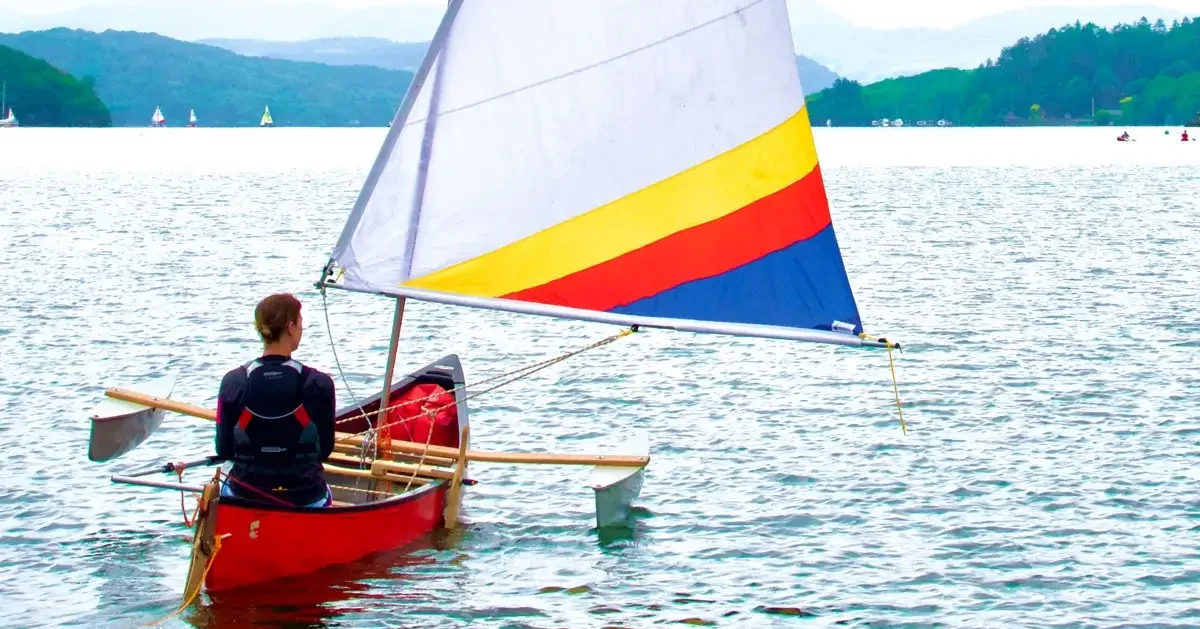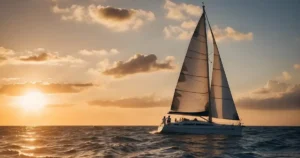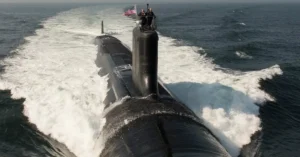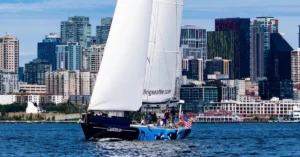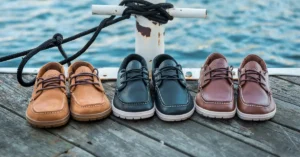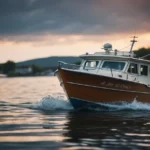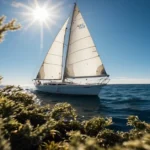Embark on a journey with your Sailing Canoe and transform every stroke into an exhilarating adventure. This concise guide is your compass to navigating the essentials of sailing canoeing in 2024, ensuring you’re well-equipped for the tranquility and thrill that awaits.
Discover how to merge the serene art of canoeing with the dynamic excitement of sailing, and let me steer you toward an unforgettable experience on the water. Whether you’re gliding peacefully on a quiet lake or embracing the challenge of gusty winds, our insights will secure your connection with nature and fuel your passion for exploration.
As a sailing canoe enthusiast, I’ve crafted this guide to share the vital Sailing Canoe essentials for 2024. Dive into this Guide and navigate your aquatic adventures with ease and excitement.
3 Reasons Why I Love Sailing Canoes
I was in for a treat when I first stepped into a sailing canoe. The unique combination of paddling a canoe with the art of Sailing has become a passion of mine, and here’s why:
- Versatility on the Water
- Paddling and Sailing: I get the best of both worlds – paddling when the wind is calm and hoisting the sail when the breeze picks up.
- Maneuverability: Canoes are incredibly agile, making navigating through various water conditions thrilling.
- Connection with Nature
- Silent Gliding: The peacefulness of gliding over the water with only the sound of the wind and waves is incomparable.
- Wildlife Watching: I often find myself up close with nature, from curious ducks to playful otters, all without disturbing their habitat.
- Affordability and Accessibility
- Low Cost: With minimal equipment needed, I didn’t break the bank to start sailing. Learning about the economic aspect of setting up a sailing canoe helped keep expenses manageable.
- Transport and Storage: Canoes are more accessible to transport and store than larger boats so I can sail more often and with less hassle.
Above all, every trip in my sailing canoe is an adventure, offering unlimited moments of joy and a great way to disconnect from the hustle of life.
Sailing Techniques and Handling

In my experience, understanding the dynamics of a sailing canoe is essential for anyone looking to harness the wind effectively. Let’s navigate the pivotal sailing techniques and the nuances of handling these versatile vessels.
Basics of Sailing
When I first learned about Sailing, mastering the basics was crucial. The last step is the foundation, where the mast is secured to the canoe, playing a pivotal role in the overall balance and performance of the craft. Leeboards counteract the sideways drift caused by the wind, and their proper use is essential for maintaining the desired direction.
A well-designed sail rig is critical to capturing the wind’s energy. I’ve seen a variety of rigs, from simple square sails to more complex Bermudian setups. The sail shape and size influence how the canoe reacts to the wind, affecting speed and maneuverability.
- Sail Rigs: Square, Bermudian, Lateen
- Fundamental Components: Mast, Boom, Leeboards
Operating a Sailing Canoe
Operating a sailing canoe involves a mix of Sailing and paddling. It’s about finding the right balance between using the paddle for propulsion and steering and the sail for harnessing the wind’s power. Successful launching is the first step, ensuring the canoe is pointed into the wind to prevent it from capsizing.
I’ve learned that when it comes to steering and control, it’s essential to adjust the sail to pivot the canoe in response to the wind and the water current. Heading upwind can be challenging, but I can progress forward without being directly against the wind by tacking- zigzagging at an angle.
Moreover, I pay close attention to maintaining proper weight distribution to avoid capsizing. When the canoe tips, knowing to right it quickly and effectively is essential.
- Steering Methods: Paddle, Rudder, Weight Shift
- Capsize Recovery: Righting the Canoe, Bail Out Water
By mastering these techniques, I have found that sailing a canoe isn’t just about the thrill but the profound connection with the water and the wind.
Safety and Maintenance

When I embark on adventures in my sailing canoe, I prioritize two crucial aspects: staying safe and keeping my craft in top condition. The open water presents unique challenges, so I’m always prepared with the right safety gear and well-versed in routine maintenance actions.
Safety Gear and Precautions
My safety on the water begins with donning a life jacket. I ensure it’s snug and comfortable because it’s a non-negotiable safety equipment. Beyond the life jacket, I carry a waterproof kit that includes:
- Marine-grade aluminum whistle
- Reflective tape and safety lights
- Emergency flotation devices
I also monitor the canoe’s stability by regularly checking the ribs and beams’ framework because they affect how well the canoe handles in different conditions. These components must be durable and withstand sudden shifts in weight or direction.
Upkeep and Repair
A well-maintained sailing canoe makes for worry-free exploration. Here’s a simple table I follow to keep my canoe in the best condition:
| Frequency | Maintenance Task |
| After each use | Quickly rinse to remove debris and saltwater |
| Monthly | Inspection for wear on the wetted surface |
| Every six months | Check the framework and all fastenings |
| Annually | Apply a marine-grade finish to protect the hull |
Regular care and maintenance are as much a part of the sailing canoe experience as the joy of catching the wind. Keeping my canoe in shipshape not only ensures longevity but also means that it’s always ready for my next adventure.
Types and Uses of Sailing Canoes

When I think of a sailing canoe, I picture a sleek vessel that perfectly blends the worlds of paddling and Sailing. Whether for an afternoon tour in a local lake or a competitive race that tests skill and speed, these canoes offer a beautiful way to experience the water.
Varieties of Sailing Canoes
Sailing canoes come in mesmerizing varieties with characteristics catering to different needs and environments. Open paddling canoes equipped with a simple sail rig, such as a small poling pole rig, offer an easy entry into Sailing without much modification. These can be crafted from materials like Dacron or Kevlar for durability and performance.
For those interested in a design that transcends cultures, the Proa, originating from the Pacific Ocean region, exhibits a distinctive asymmetrical form and an outrigger for stability. Kayak-style sailing canoes, narrower and often more streamlined, are designed to slice through the water quickly. Some canoes are fitted with a black sail, which looks striking and holds up well under diverse weather conditions.
Recreational and Competitive Sailing
Sailing canoes aren’t just about leisurely cruising; they open up exhilarating new horizons for competitive Sailing, too. Racing canoes are built lightweight yet seaworthy, ready to tackle the rigors of a race in various conditions. Events across Europe and the globe see sailors pitting their skills against one another, often with the canoe sail rig tuned to perfection for optimum performance.
On the other hand, recreational sailing canoes prioritize portability and ease of use. They allow enthusiasts to relax and explore local lakes, rivers, and coasts. The feeling of the wind propelling me silently over the water is a joy, whether seeking solace in nature or having a fun day out with friends.
FAQ – Sailing Canoe

When I think about adventure on the water, sailing canoes immediately come to mind. They’re a perfect mix of traditional paddling and the excitement of harnessing the wind – Check out these FAQs, and you will have a lot of Fun and Joy at your next Sailing Canoe Adventure.
How fast can a canoe with a sail go?
The speed of a sailing canoe can vary widely based on factors like the wind conditions, the sail’s size, and the canoe’s design. Generally, canoes fitted with sails can achieve speeds between 5 to 10 knots (5.75 to 11.5 mph), but this can increase under optimal conditions or with racing designs.
Can canoes have sails?
Absolutely! Canoes can be equipped with sails to enhance their propulsion, and doing so combines paddling with the thrill of Sailing. Even specific rigs are designed for canoes to optimize their performance under sail.
If you’re curious about one of these rigs, check out this guide for a Drop-in Sailing Rig for canoes and kayaks, which explains how to add sails to these versatile boats.
What makes a canoe seaworthy?
A seaworthy canoe demonstrates stability, buoyancy, and the ability to handle various water conditions safely. Factors contributing to a canoe’s seaworthiness include:
A strong and durable build, often from materials like fiberglass, Kevlar, or resilient plastics.
Design features like flared sides, a keel, and defined stems help with waves and provide directional stability.
An appropriate length-to-width ratio—longer and narrower canoes are typically faster and track better, while wider canoes offer more stability.
Go Aboard on the conversation and share your Own Sailing Canoe Essentials and experiences in the comments below.

